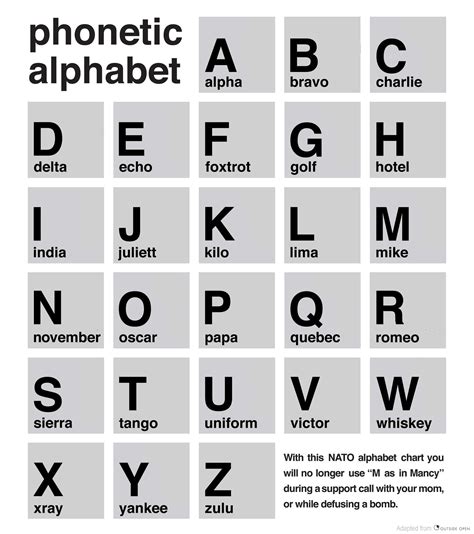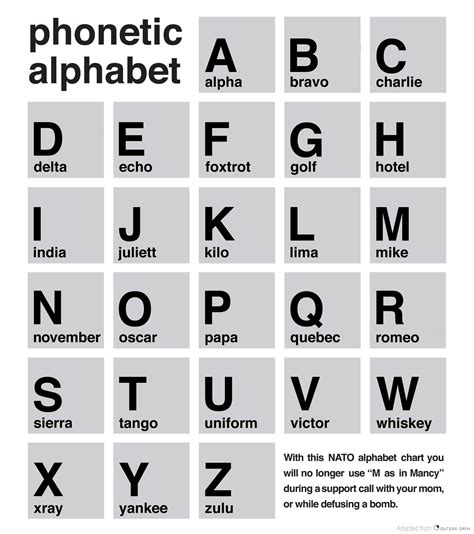Mastering the NATO Phonetic Alphabet in 5 Easy Steps

Introduction to the NATO Phonetic Alphabet

Effective communication is crucial in various fields, including aviation, navigation, and international business. However, standard letter pronunciation can lead to misunderstandings, especially when communicating over radio or phone. To address this issue, the NATO Phonetic Alphabet, also known as the International Radiotelephony Spelling Alphabet, was developed. This alphabet assigns a unique code word to each letter of the standard alphabet, ensuring clear and precise communication.
Why Use the NATO Phonetic Alphabet?

The NATO Phonetic Alphabet is essential for accurate and efficient communication in various situations:
- Aviation and Navigation: Clear communication is vital for air traffic control, navigation, and emergency situations.
- International Business: The alphabet helps to avoid misunderstandings when communicating with people who speak different languages.
- Radio and Phone Communication: The NATO Phonetic Alphabet ensures accurate transmission of messages, reducing errors and misunderstandings.
Step 1: Learn the Basic Principles

To master the NATO Phonetic Alphabet, start by understanding its basic principles:
- Unique Code Words: Each letter of the standard alphabet has a unique code word.
- Phonetic Pronunciation: Code words are pronounced phonetically, making them easy to understand.
- Standardized: The NATO Phonetic Alphabet is standardized, ensuring consistency across different languages and regions.
Step 2: Familiarize Yourself with the Alphabet

Here is the NATO Phonetic Alphabet:
| Letter | Code Word |
|---|---|
| A | Alpha |
| B | Bravo |
| C | Charlie |
| D | Delta |
| E | Echo |
| F | Foxtrot |
| G | Golf |
| H | Hotel |
| I | India |
| J | Juliet |
| K | Kilo |
| L | Lima |
| M | Mike |
| N | November |
| O | Oscar |
| P | Papa |
| Q | Quebec |
| R | Romeo |
| S | Sierra |
| T | Tango |
| U | Uniform |
| V | Victor |
| W | Whiskey |
| X | X-ray |
| Y | Yankee |
| Z | Zulu |

Step 3: Practice, Practice, Practice!

To become proficient in the NATO Phonetic Alphabet, practice is essential:
- Recite the Alphabet: Repeat the alphabet several times to commit it to memory.
- Use Flashcards: Create flashcards with letters on one side and code words on the other.
- Practice with Examples: Use examples, such as your name or a phrase, to practice spelling using the NATO Phonetic Alphabet.
Step 4: Apply the Alphabet in Real-Life Situations

Apply the NATO Phonetic Alphabet in real-life situations to reinforce your learning:
- Radio and Phone Communication: Use the alphabet when communicating over radio or phone.
- Aviation and Navigation: Use the alphabet when communicating with air traffic control or navigation systems.
- International Business: Use the alphabet when communicating with people who speak different languages.
Step 5: Refine Your Skills

To refine your skills, focus on the following:
- Pronunciation: Pay attention to correct pronunciation of code words.
- Speed: Practice spelling quickly and accurately.
- Accuracy: Focus on accuracy, especially in critical situations.
📝 Note: The NATO Phonetic Alphabet is a standardized system, but it's essential to use it consistently to avoid confusion.
In conclusion, mastering the NATO Phonetic Alphabet requires practice, patience, and dedication. By following these five easy steps, you’ll become proficient in the alphabet and be able to communicate accurately and efficiently in various situations.
What is the NATO Phonetic Alphabet?

+
The NATO Phonetic Alphabet is a standardized alphabet used for clear and precise communication, especially in situations where standard letter pronunciation may lead to misunderstandings.
Why is the NATO Phonetic Alphabet important?

+
The NATO Phonetic Alphabet is essential for accurate and efficient communication in various fields, including aviation, navigation, and international business.
How do I practice the NATO Phonetic Alphabet?

+
Practice the NATO Phonetic Alphabet by reciting the alphabet, using flashcards, and practicing with examples. Apply the alphabet in real-life situations to reinforce your learning.